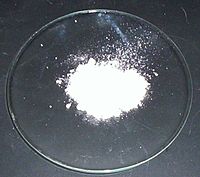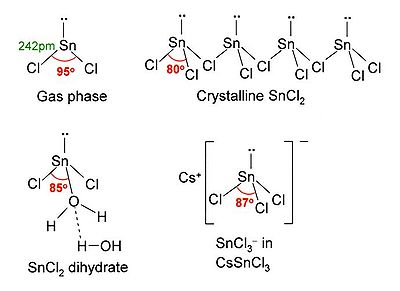
Tin(II) chloride
Background Information
SOS Children made this Wikipedia selection alongside other schools resources. Child sponsorship helps children one by one http://www.sponsor-a-child.org.uk/.
| Tin(II) chloride | |
|---|---|
 |
|
|
Tin(II) chloride |
|
|
Other names
Stannous chloride |
|
| Identifiers | |
| RTECS number | XP8700000 (anhydrous) XP8850000 (dihydrate) |
| Properties | |
| Molecular formula | SnCl2 |
| Molar mass | 189.60 g/mol (anhydrous) 225.63 (dihydrate) |
| Appearance | White crystalline solid |
| Density | 3.95 g/cm³, anhydrous solid 2.71 g/cm³, dihydrate (15 °C) |
| Melting point |
246 °C (519 K) |
| Boiling point |
623 °C (896 K) |
| Solubility in water | 83.9 g/100 ml (0 °C) Hydrolyses in hot water |
| Structure | |
| Crystal structure | Layer structure (chains of SnCl3 groups) |
| Coordination geometry |
Trigonal pyramidal (anhydrous) Dihydrate also three-coordinate |
| Molecular shape | Bent (gas phase) |
| Hazards | |
| MSDS | External MSDS |
| R-phrases | 22-34-37 |
| S-phrases | 26-36/37/39-45 |
| Main hazards | Corrosive |
| Related compounds | |
| Other anions | Tin(II) fluoride Tin(II) bromide |
| Other cations | Tin(IV) chloride Germanium dichloride Lead(II) chloride |
| Supplementary data page | |
| Structure and properties |
n, εr, etc. |
| Thermodynamic data |
Phase behaviour Solid, liquid, gas |
| Spectral data | UV, IR, NMR, MS |
| Except where noted otherwise, data are given for materials in their standard state (at 25 °C, 100 kPa) | |
| Infobox references | |
Tin(II) chloride (stannous chloride) is a white crystalline solid with the formula SnCl2. It forms a stable dihydrate, but aqueous solutions tend to undergo hydrolysis, particularly if hot. SnCl2 is widely used as a reducing agent (in acid solution), and in electrolytic baths for tin-plating. Tin(II) chloride should not be confused with the other chloride of tin; tin(IV) chloride or stannic chloride (SnCl4).
Chemical structure
SnCl2 has a lone pair of electrons, such that the molecule in the gas phase is bent. In the solid state, crystalline SnCl2 forms chains linked via chloride bridges as shown. The dihydrate is also three-coordinate, with one water coordinated on to the tin, and a second water coordinated to the first. The main part of the molecule stacks into double layers in the crystal lattice, with the "second" water sandwiched between the layers.
Chemical properties
Tin(II) chloride can dissolve in less than its own mass of water without apparent decomposition, but as the solution is diluted hydrolysis occurs to form an insoluble basic salt:
- SnCl2(aq) + H2O(l) ↔ Sn(OH)Cl(s) + HCl(aq)
Therefore if clear solutions of tin(II) chloride are to be used, hydrochloric acid must be added in order to maintain the equilibrium towards the left-hand side (using Le Chatelier's principle). Solutions of SnCl2 are also unstable towards oxidation by the air:
This can be prevented by storing the solution over lumps of tin metal.
There are many such cases where tin(II) chloride acts as a reducing agent, reducing silver and gold salts to the metal, and iron(III) salts to iron(II), for example:
- SnCl2(aq) + 2 FeCl3(aq) → SnCl4(aq) + 2 FeCl2(aq)
Solutions of tin(II) chloride can also serve simply as a source of Sn2+ ions, which can form other tin(II) compounds via precipitation reactions, for example brown (or black) tin(II) sulfide:
- SnCl2(aq) + Na2S(aq) → SnS(s) + 2 NaCl(aq)
If alkali is added to a solution of SnCl2, a white precipitate of hydrated tin(II) oxide forms initially; this then dissolves in excess base to form a stannite salt such as sodium stannite:
- SnO·H2O(s) + NaOH(aq) → NaSn(OH)3(aq)
Anhydrous SnCl2 can be used to make a variety of interesting tin(II) compounds in non-aqueous solvents. For example, the lithium salt of 4-methyl-2,6-di-tert-butylphenol reacts with SnCl2 in THF to give the yellow linear two-coordinate compound Sn(OAr)2 (Ar = aryl).
Tin(II) chloride also behaves as a Lewis acid, forming complexes with ligands such as chloride ion, for example:
- SnCl2(aq) + CsCl(aq) → CsSnCl3(aq)
Most of these complexes are pyramidal, and since complexes such as SnCl3 have a full octet, there is little tendency to add more than one ligand. The lone pair of electrons in such complexes is available for bonding, however, and therefore the complex itself can act as a Lewis base or ligand. This seen in the ferrocene-related product of the following reaction :
- SnCl2 + Fe(η5-C5H5)(CO)2HgCl → Fe(η5-C5H5)(CO)2SnCl3 + Hg
SnCl2 can be used to make a variety of such compounds containing metal-metal bonds, for example:
- SnCl2 + Co2(CO)8 → (CO)4Co-(SnCl2)-Co(CO)4
Preparation
Anhydrous SnCl2 is prepared by the action of dry hydrogen chloride gas on tin metal. The dihydrate is made by a similar reaction, using hydrochloric acid:
The water is then carefully evaporated from the acidic solution to produce crystals of SnCl2·2H2O. This dihydrate can be dehydrated to anhydrous using acetic anhydride.
Uses
A solution of tin(II) chloride containing a little hydrochloric acid is used for the tin-plating of steel, in order to make tin cans. An electric potential is applied, and tin metal is formed at the cathode via electrolysis.
It is used as a catalyst in the production of the plastic polylactic acid (PLA).
Tin(II) chloride also finds wide use as a reducing agent. This is seen in its use for silvering mirrors, where silver metal is deposited on the glass:
- Sn2+(aq) + 2 Ag+ → Sn4+(aq) + 2 Ag(s)
A related reduction was traditionally used as an analytical test for Hg2+(aq). For example, if SnCl2 is added dropwise into a solution of mercury(II) chloride, a white precipitate of mercury(I) chloride is first formed; as more SnCl2 is added this turns black as metallic mercury is formed. Stannous chloride can be used to test for the presence of gold compounds. SnCl2 turns bright purple in the presence of gold.
This very reaction between stannous chloride and gold was used in episode #215: Clueless of House to affirm gold poisoning.
In organic chemistry, SnCl2 is mainly used in the Stephen reduction, whereby a nitrile is reduced (via an imidoyl chloride salt) to an imine which is easily hydrolysed to an aldehyde.
The reaction usually works best with aromatic nitriles Aryl-CN. A related reaction (called the Sonn-Müller method) starts with an amide, which is treated with PCl5 to form the imidoyl chloride salt.
The Stephen reduction is less used today, because it has been mostly superseded by diisobutylaluminium hydride reduction.
Additionally, SnCl2 is used to selectively reduce aromatic nitro groups to anilines.
SnCl2 also reduces quinones to hydroquinones.
Stannous chloride is also added as a food additive with E number E512 to some canned and bottled foods, where it serves as a colour-retention agent and antioxidant.
In Popular Culture
This compound was featured in the House, M.D. episode “ Clueless,” wherein it was used to detect the presence of gold sodium thiomalate used by the patient’s wife to poison him.


